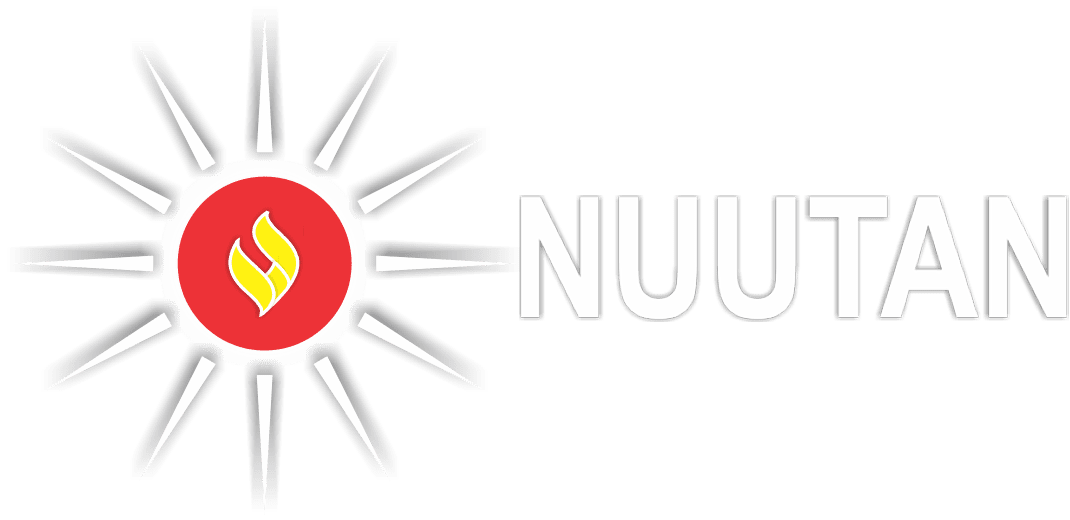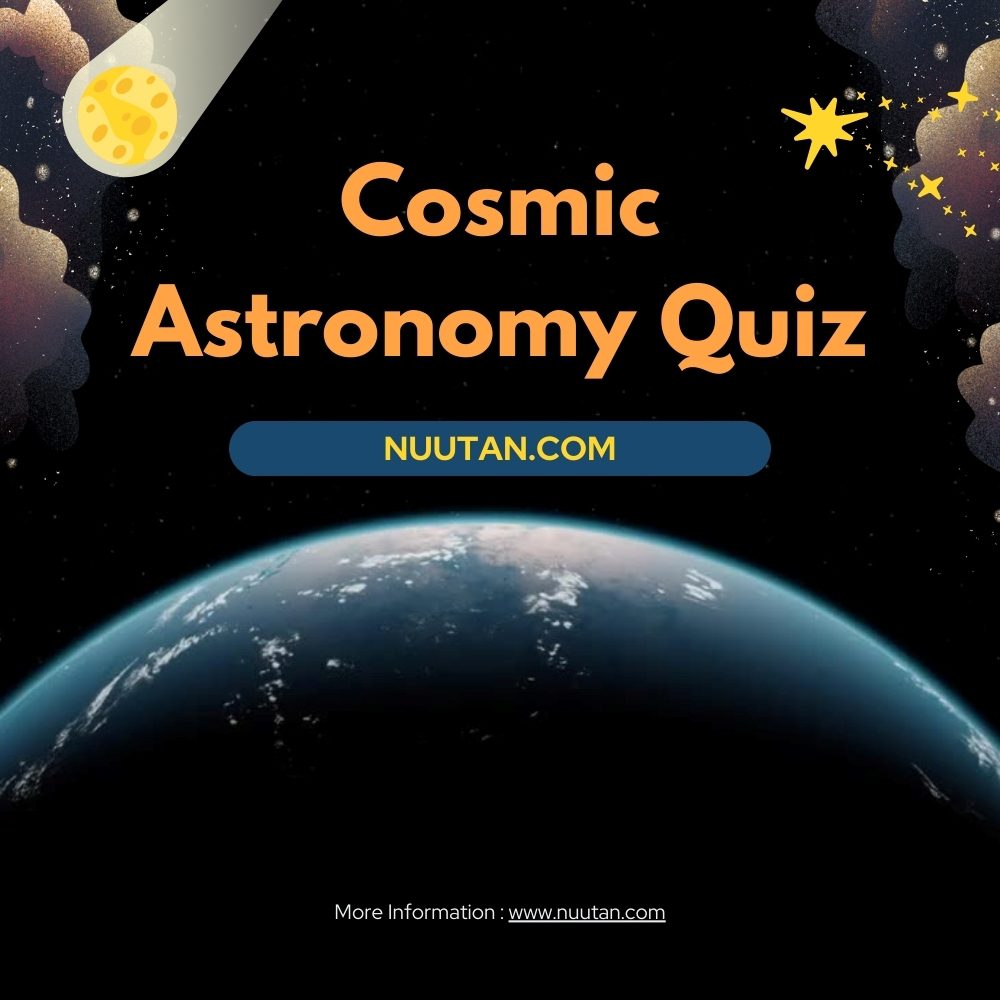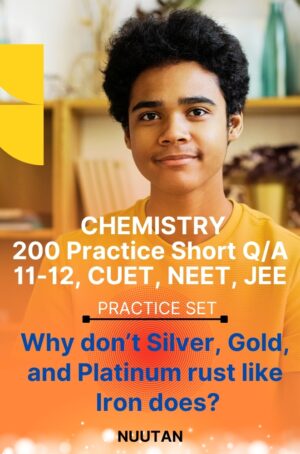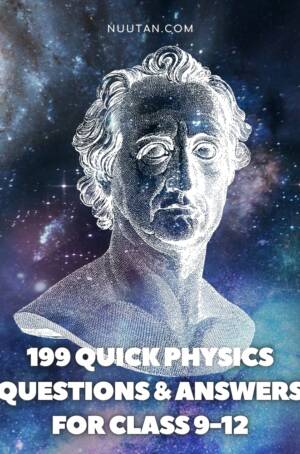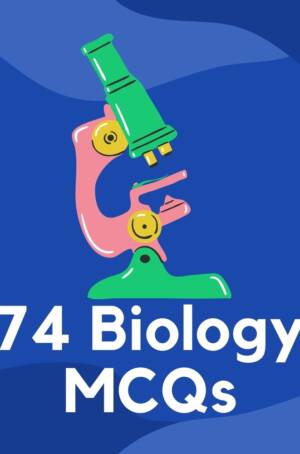Description
Cosmic Astronomy Quiz:
Question-1: In our solar system’s intricate setup, which celestial object hosts the largest ring-shaped storm on its outer gas layer, from these options?
a) Jupiter
b) Venus
c) Uranus
d) Earth
Answer-1: It’s Jupiter. This is due to the Great Red Spot, a massive high-pressure storm in Jupiter’s atmosphere, recognized as the biggest circular tempest in our system. Recent data shows it measures about 16,350 km long and 11,000 km wide, lasting over 300 years with winds up to 432 km/h. This far exceeds Earth’s storms and highlights Jupiter’s active weather, fueled by inner heat and fast spin.
Question-2: What name is given to the fast stream of charged particles released from the sun’s outer layer into space?
Answer-2: It’s solar wind. This steady flow mainly includes protons, electrons, and helium ions moving at 300-800 km/s, carrying the sun’s magnetic field across space. It interacts with planetary fields, directs comet tails away from the sun, and causes Earth’s auroras. Discovered via spacecraft in the 1950s, it varies with the sun’s 11-year cycle and shapes space weather.
Question-3: Among known small bodies in our system, which is the largest by size?
a) Vesta
b) Icarus
c) Ceres
d) Eros
Answer-3: It’s Ceres. Found in 1801 by Giuseppe Piazzi, Ceres is the biggest in the asteroid belt between Mars and Jupiter, with a 940 km diameter and about 25% of the belt’s mass (9.39 × 10^20 kg). Reclassified as a dwarf planet in 2006 by the IAU for its round shape and gravity control, it differs from jagged asteroids and aids in studying system origins.
Question-4: Rounded to the nearest full day, how long is Mercury’s orbit around the sun relative to stars?
a) 111 days
b) 88 days
c) 50 days
d) 25 days
Answer-4: It’s 88 days. Mercury’s sidereal year is exactly 87.97 Earth days, often rounded up, due to its close 0.39 AU orbit and 47 km/s speed. This follows Kepler’s third law (period squared proportional to distance cubed). Unlike its 3:2 spin-orbit lock, creating a 176-day solar day.
Question-5: What body in our system features what might be the tallest volcano, Olympus Mons?
a) Jupiter’s moon Callisto
b) Venus
c) Saturn’s moon Titan
d) Mars
Answer-5: It’s Mars. Olympus Mons is a huge shield volcano rising 22 km high with a 600 km base, the system’s tallest. Built from repeated lava flows over billions of years, thanks to Mars’ low gravity and no plate tectonics allowing fixed hotspots. In the Tharsis area, its calderas show chamber collapses, revealing Mars’ geologic past.
Question-6: What world holds what could be the biggest volcanic structure in our system, Olympus Mons?
Answer-6: It’s Mars. As noted, Olympus Mons forms from gentle-sloped lava builds, possible due to long eruptions without plate movement—unlike Earth’s shifting crust. Recent data hints at activity as recent as 2 million years ago, tied to mantle rises in Tharsis, shedding light on Mars’ heat loss and land changes.
Question-7: How long is one full spin on Jupiter, matching a day, from these times?
a) 30 hrs 40 min
b) 9 hrs 50 min
c) 3 hrs 20 min
d) 52 hrs 10 min
Answer-7: It’s 9 hrs 50 min. Jupiter’s equatorial sidereal day is about that, making it the quickest spinner among planets. This causes bulging (equator 6% wider than poles), powers its magnetic field, and creates cloud bands with varying speeds by latitude, including winds to 600 km/h in ammonia layers.
Question-8: What term describes the time between repeated alignments of a body (like a planet or moon) with the sun and Earth?
a) a conjunction
b) an opposition
c) a sidereal period
d) a synodic period
Answer-8: It’s a synodic period. This measures return to the same Earth-sun setup, like moon phases or planet view cycles. Unlike sidereal (star-based), it drives viewing times—close planets at conjunctions, far ones at oppositions. Key for sky watching and orbit studies.
Question-9: Between 1979 and 1998, which planet was farthest from the sun?
Answer-9: It’s Neptune. Pluto’s oval path crossed inside Neptune’s circle then, making Neptune temporarily outermost. Pluto’s 0.25 eccentricity and 17° tilt cause these shifts, last from 1979-1999, next in the 2200s. This shows outer orbit changes and led to Pluto’s dwarf reclass.
Question-10: Roughly, how long does energy from the sun’s core fusion take to reach the surface and escape?
a) Three minutes
b) Thirty days
c) One thousand years
d) One million years
Answer-10: It’s one million years. Photons from core gamma rays scatter endlessly in the dense radiative zone, slowly becoming visible light. Convection speeds it near the surface. Models estimate this, unlike the 8-minute trip to Earth, showing dense interior delays.
Question-11: What’s the cycle length for sunspot peaks, tied to solar magnetism?
a) 3 years
b) 11 years
c) 26 years
d) 49 years
Answer-11: It’s 11 years. The Schwabe cycle sees sunspot rises and falls from rotation twisting fields, flipping poles each cycle (full Hale 22 years). This boosts flares, ejections, and Earth effects, tracked since 1600s, with peaks active and lows calm.
Question-12: What two star traits does the Hertzsprung-Russell diagram plot directly?
a) size
b) temperature
c) luminosity
d) density
Answer-12: Temperature and luminosity. It shows temp vs. brightness, mapping paths like main sequence, giants, and dwarfs. Radius from Stefan-Boltzmann, mass inferred—size/density not direct. Vital for star life and group studies.
Question-13: What shape type is the Andromeda Galaxy?
a) elliptical
b) spiral
c) barred-spiral
d) irregular
Answer-13: It’s spiral. M31 is barred spiral with arms from a bar, like our galaxy. 2.5 million light-years in Andromeda constellation, naked-eye visible, Hubble Sb class, studied for spin, formation, and growth.
Question-14: About how wide is the Milky Way in light-years?
a) 1,000
b) 10,000
c) 100,000
d) 1,000,000
Answer-14: 100,000 light-years. Disk with arms, bulge, halo; sun 26,000 from center. Measured by stars, radio H maps, Gaia. Barred spiral in Local Group, disk 1,000 thick, halo wider.
Question-15: Which Apollo flight, aimed at moon landing, stopped after an oxygen tank burst?
Answer-15: Apollo 13. 1970 launch, explosion en route; Lovell, Swigert, Haise used lunar module to return, fixing CO2, saving power. Safe splashdown showed NASA crisis skills; famous “Houston, problem” line.
Question-16: What device first proved Earth’s spin on its axis?
Answer-16: Foucault pendulum. 1851 by Léon Foucault, bob swings plane seeming to turn as Earth rotates—24 hrs at poles, none equator. Shows Coriolis, independent of stars.
Question-17: What’s the smallest planet in our system?
Answer-17: Pluto. Dwarf since 2006, 2,377 km diameter < moon’s, 39 AU eccentric orbit, rock-ice. 1930 Tombaugh find; IAU says no orbit clear.
Question-18: Which body has a moon almost as big as itself?
Answer-18: Pluto. Charon 1,212 km, half Pluto, binary barycenter outside. 1978 Christy discovery, tidal lock unique. Impact formation? Kuiper dynamics.
Question-19: What space milestone did Sally K. Ride achieve?
Answer-19: First U.S. woman in space. 1983 STS-7 Challenger, specialist deploying sats, experiments. Stanford physics; inspired women, later disaster probes.
Question-20: What year did Neil Armstrong walk on the moon?
Answer-20: 1969. July 20 Apollo 11, “small step” quote, Aldrin joined, samples, experiments. Kennedy goal met, space race peak.
Question-21: Which unique planet has a day longer than its year?
Answer-21: Venus. 243-day retrograde spin > 225-day orbit, from tides, atmosphere. Solar day 117 Earth days, 467°C heat, radar found.
Question-22: What is Charon (kar-en, C-h-a-r-o-n)?
Answer-22: Pluto’s moon. 1978 Christy, half Pluto size, binary. Myth ferryman name, New Horizons 2015: active surface, canyons, plains. Kuiper insights.
Question-23: Where is Cassini’s division?
Answer-23: Saturn’s rings gap. 4,800 km between A/B rings, 1675 Cassini. Mimas resonance clears it, Voyager low density, shows moon shepherding.
Question-24: Who was the first African American in space?
Answer-24: Guion S. Bluford. 1983 STS-8 Challenger, specialist sats, night ops. Physics/aero background, 688 space hours, boosted NASA diversity.
Question-25: What was Vostok 1 in space history?
Answer-25: First human spacecraft. 1961 Gagarin one orbit, 327 km, 108 min. Soviet win, ejected parachute land, proved human space survival.
Question-26: Heliocentric (he-lee-o-sen-trik) means orbiting what?
a) Jupiter
b) the Moon
c) the Sun
d) Neptune
Answer-26: The Sun. Model sun center, planets around, Copernicus 1543, vs geocentric. Galileo/Kepler confirmed, base modern astronomy, gravity dynamics.
Question-27: What liquid makes up Triton’s ocean-like feature, Neptune’s moon?
Answer-27: Nitrogen. Thin air, possible under-ice nitrogen/methane sea, cryovolcanoes geysers. Voyager 1989 pink tholins, 38 K cold, like Earth cycle but frozen. Exoplanet parallels.
Question-28: Who first ranked star brightnesses, starting with Mars?
a) Aristarchus
b) Pythagorus
c) Copernicus
d) Hipparchus
Answer-28: Hipparchus. 2nd BC magnitude 1-6, Mars included, 850-star catalog, Ptolemy base, precession find. Scale now log, apparent magnitude.
Question-29: What was the Schmidt telescope made for?
a) a sky camera
b) a radio telescope
c) an optical telescope
d) a solar telescope
Answer-29: Sky camera. 1930 Bernhard Schmidt, corrector lens wide-field no aberrations, photo surveys like Palomar. Catadioptric, changed sky imaging.
Question-30: What’s the closest star to our sun?
Answer-30: Proxima Centauri. Red dwarf 4.24 light-years, Alpha Centauri triple part. 1915 find, Proxima b planet, interstellar target.
Question-31: In orbits, the farthest point from the sun is?
a) aphelion (ah-feel-yen)
b) perihelion (per-eh-heel-yen)
c) helix
d) eccentricity
Answer-31: Aphelion. Opposite perihelion, Greek “away.” Earth July ~152 million km, seasons from tilt not distance. Eccentricity measures ovalness.
Question-32: What are very bright meteors or fireballs called?
Answer-32: Fireballs. > -4 magnitude, big meteoroids, may explode bolides, wide visible, meteorite links. Networks track orbits, NEO studies.
Question-33: How does Mars’ air pressure compare to Earth’s?
a) about the same
b) 100 times greater
c) 1/200th
d) half
Answer-33: 1/200th. ~6 mbar vs 1013, ~1/167 approx 1/200. CO2 thin, lost to space/freeze. Dust storms ok, no liquid water.
Question-34: What’s the main gas in Mars’ atmosphere?
Answer-34: Carbon dioxide. 95.3%, trace N/Ar. Weak greenhouse, -63°C avg, polar ice sublimes, dust cycles. Rovers seek past life.
Question-35: Jupiter’s mass vs other planets:
a) = Earth + Mars
b) = Saturn + Pluto
c) = Saturn + Neptune + Uranus
d) > all combined
Answer-35: > all combined. 1.898e27 kg, 318 Earths > rest total. Dominates, protects inners, affects asteroids/comets.
Question-36: What lunar feature is Copernicus?
a) sea
b) crater
c) mountain range
d) rill
Answer-36: Crater. 93 km, rays 800 km, young impact Oceanus Procellarum. Terraces, peaks show complex form, stratigraphy insights.
Question-37: When does northern summer start from sun position?
Answer-37: June 21. Solstice, longest day, sun +23.5° declination. Tilt causes, cultures celebrate.
Question-38: What season in north when Earth farthest from sun?
Answer-38: Summer. Aphelion July, tilt > 3% distance effect. South winter. Tilt key.
Question-39: Which two planets have no moons?
Answer-39: Mercury, Venus. Inner, sun tides disrupt. Outer have many from disks.
Question-40: British “Chained Lady” constellation formal name?
Answer-40: Andromeda. Myth princess, M31 galaxy, stars Alpheratz/Mirach. Autumn sky guide.
Question-41: When is Pegasus usually seen, like Hercules summer?
Answer-41: Autumn. Rises east fall, Great Square asterism, Andromeda pointer.
Question-42: Which constellation has bright Vega?
Answer-42: Lyra. Summer Triangle part, Vega 25 ly, past pole star. Ring Nebula M57.
Question-43: Where is Aldebaran, “Demon Star”?
Answer-43: Taurus. Bull eye, orange giant 65 ly, Hyades. Winter, moon occultations.
Question-44: For binary star mass total, need what two measures?
Answer-44: Separation and revolution period. Kepler law: period sq to axis cube / mass. Key evolution studies.
Question-45: What nebula type is Orion cloud?
Answer-45: Emission. H ionized by young stars, red H-alpha, nursery M42, Trapezium.
Question-46: What are fast charged particles in space medium?
Answer-46: Cosmic rays. From supernovae/AGN, near light speed, showers detected, radiation risk, high-energy physics.
Question-47: How many stars in typical spiral galaxy like ours?
a) 10 billion
b) 40 billion
c) 200 billion
d) 800 billion
Answer-47: 200 billion. 100-400 range, types O-M, disk/bulge/halo, counts/velocity/Gaia. Mass/dark matter.
Question-48: What path does sun seem to take yearly on sky?
Answer-48: Ecliptic. Earth orbit projection, zodiac, 23.5° tilt seasons, coords/calendar.
Question-49: Refracting telescopes always use:
a) mirrors
b) lenses
c) TV systems
d) film
Answer-49: Lenses. Bend light focus, chromatic fixed achromats, vs reflectors mirrors.
Question-50: Comet tail always points:
a) toward sun
b) toward earth
c) behind orbit
d) away sun
Answer-50: Away sun. Wind/radiation push ion/dust tails, sublimate near sun.
Question-51: Magnetic split of spectral lines:
a) Boltzmann
b) Zeeman
c) Planck
d) Zanstra
Answer-51: Zeeman. 1896, proportional field, measures star/sun fields, polarized. MHD key.
Question-52: Latin name for dark flat moon “seas”?
Answer-52: Mare/maria. Basalt plains, ancient lava, 16% surface, nearside mostly, Galileo misname, Apollo samples.
Question-53: Term for small rocks, 99.8% between Mars/Jupiter?
Answer-53: Asteroids. Formation leftovers, belt 1M+, Ceres dwarf, missions resources/risks.
Question-54: Elliptical/spiral/irregular are types of:
Answer-54: Galaxies. Hubble scheme: shape/evolution/gas, billions, Milky barred spiral.
Question-55: Cool (3-4K K) big (100 sun) star type?
Answer-55: Red giant. Post-main H exhaust, He fuse expand, cool red, Betelgeuse, later supernova/white dwarf.
Question-56: Magnitude 5 brighter than 8 by factor?
Answer-56: 15.85 (15-16 ok). Log scale, 3 mag = 2.512^3 ~16, 5 mag=100.
Question-57: True for Saturn/Jupiter:
a) both faster Earth spin
b) both slower
c) one fast one slow
d) spin linked orbit
Answer-57: Both faster. 9.9/10.7 hrs vs 24, oblate, fields, bands/storms.
Question-58: Orion is:
a) brightest star
b) constellation
c) NASA craft
d) asteroid
Answer-58: Constellation. Winter, Rigel/Betelgeuse, belt/nebula, navigation.
Question-59: Author “On Revolutions Celestial Orbs”:
a) Kepler
b) Euclid
c) Copernicus
d) Newton
Answer-59: Copernicus. 1543 heliocentric, challenged geo, inspired Galileo/Kepler.
Question-60: Term for three bodies straight line?
Answer-60: Syzygy. Eclipses/transits, tides, Greek yoked.
Question-61: Most eccentric orbit planet?
Answer-61: Pluto. 0.248, crosses Neptune, Kuiper, dwarf reason.
Question-62: Retrograde motion true:
a) epicycles
b) only superior
c) only inferior
d) orbit projection
Answer-62: Orbit projection. Earth pass causes loop, Copernicus explained no epicycles.
Question-63: Name mid-60s US two-crew space series?
Answer-63: Gemini. 10 flights, EVA/rendezvous/dock, Mercury-Apollo bridge.
Question-64: What happens when huge star explodes post-supergiant?
Answer-64: Supernova (II/neutron star/black hole). Core collapse, eject layers, elements, remnant.
Question-65: Beads around moon at total eclipse start/end:
a) Lunar
b) Solar
c) Baily’s
d) Rim
Answer-65: Baily’s. Sun through valleys, 1836, seconds long, corona signal.
Question-66: Star positions use what two, like lat/long?
a) ascension
b) right ascension
c) altitude
d) declination
e) polar
Answer-66: Right ascension, declination. 0-24 hrs east vernal, -90/+90 equator. Epoch precession.
Question-67: Brightest planet in night sky usually?
Answer-67: Venus. -4.6 mag, close/high albedo, phases.
Question-68: Voyager 2 last planet?
Answer-68: Neptune. 1989, Dark Spot/moons/rings/Triton.
Question-69: Cosmic 2.7 K background in what EM band?
a) radio
b) IR
c) visible
d) UV
Answer-69: Radio (microwave). CMB, Big Bang, Penzias/Wilson, uniform/anisotropies.
Question-70: Which inner rocky pair never opposite sun?
Answer-70: Venus/Mercury. Inferior, elongation <180°, no opposition.
Question-71: Light from collapsing star to black hole disappears because:
a) redshifted
b) blueshifted
c) black color
d) none
Answer-71: Strongly redshifted. Gravity stretches waves infinite at horizon, energy loss.
Question-72: Observe through clouds in what EM?
a) visual
b) radio
c) UV
d) x-ray
Answer-72: Radio. Penetrates, telescopes 24/7, H/pulsars/CMB.
Question-73: First US probe after shuttle loss Oct 1989, name/target?
Answer-73: Galileo, Jupiter. 1995 arrive, probe/moons/magnet.
Question-74: Magellanic Clouds type?
a) irregular galaxies
b) spiral
c) elliptical
d) gas/dust clouds
Answer-74: Irregular galaxies. Tidal distort, star form, 1987A.
Question-75: Dino extinction impact evidence element at era boundary?
Answer-75: Iridium. High in meteorites, Alvarez, Chicxulub, extinction cause.
Question-76: Term for fraction light reflected by surface?
Answer-76: Albedo. 0-1, energy balance, Venus high/Earth avg.
Question-77: Auroras in what atmosphere layer?
a) troposphere
b) stratosphere
c) ozonosphere
d) ionosphere
Answer-77: Ionosphere. Particles excite gases, poles, solar activity.
Question-78: Yellow F star south Carina, 2nd brightest:
a) Canopus
b) Alpha Centauri
c) Castor
d) Rigel
Answer-78: Canopus. Supergiant, navigation, near supernova.
Question-79: North constellation W shape, 1572 supernova:
Answer-79: Cassiopeia. Circumpolar, Tycho SN, clusters.
Question-80: Same longitude bodies in:
a) sympathy
b) conjunction
c) parallel
d) series
Answer-80: Conjunction. Alignment, transits/oppositions.
Question-81: Study of universe origin/evolution:
a) tomography
b) cystoscopy
c) cryology
d) cosmology
Answer-81: Cosmology. Big Bang/dark energy/CMB.
Question-82: Penzias/Wilson find supporting Big Bang?
Answer-82: Background radiation/3K/Big Bang fireball. CMB isotropic.
Question-83: British Cambridge who calculated Neptune position?
Answer-83: John C. Adams. Uranus perturbations, 1845.
Question-84: Pair constellations for Great Square winged horse?
Answer-84: Pegasus, Andromeda. Autumn asterism, galaxy pointer.
Question-85: Gas form upper atmosphere solar UV on oxygen?
Answer-85: Ozone. Stratosphere absorb UV, hole CFCs.
Question-86: Sun mass to energy percent?
a) 50%
b) 1%
c) 2%
d) .001%
Answer-86: .001%. Tiny over time, fusion 0.7% per reaction.
Question-87: Kepler: planet paths are:
a) ellipses
b) parabolas
c) hyperbolas
d) square
Answer-87: Ellipses. Sun focus, from Brahe data.
Question-88: Kepler: distance cube to:
a) swept area
b) period cube
c) period square
d) distance fourth
Answer-88: Period square. P^2 ~ a^3, Newton mass gen.
Question-89: Coolest visible star class?
a) O
b) A
c) G
d) M
Answer-89: M. Red dwarfs, long life, flares.
Question-90: Degenerate electrons support:
a) Main Sequence Star
b) White Dwarf
c) Neutron Star
d) Black Hole
Answer-90: White dwarf. Pauli principle, Chandrasekhar limit.
Question-91: Body with moon closest mass ratio:
a) Earth
b) Mars
c) Jupiter
d) Pluto
Answer-91: Pluto. Charon 12%, binary.
Question-92: Io/Europa/Ganymede/Callisto around:
a) Jupiter
b) Saturn
c) Neptune
d) Uranus
Answer-92: Jupiter. Galilean, varied features.
Question-93: Universe age depends on:
a) The mass of the Earth
b) The speed of light
c) The Hubble Constant
d) The mass of the electron
Answer-93: Hubble constant. ~14 Gyr from 1/H0.
Question-94: First sun-center propose:
a) Alexander the Great
b) Copernicus
c) Socrates
d) Tycho Brahe
Answer-94: Copernicus. 1543, Earth third.
Question-95: Last moon crew year:
a) 1971
b) 1972
c) 1973
d) 1974
Answer-95: 1972. Apollo 17, samples/EVA.
Question-96: Big Bang relic temp:
a) 100K
b) 0K
c) 5.3K
d) 2.7K
Answer-96: 2.7K. CMB blackbody.
Question-97: Solar magnetic edge:
Answer-97: Heliopause. ~120 AU, Voyager cross.
Question-98: Galactic bubbles from events:
Answer-98: Supernovas. Gas sweep, fountains.
Question-99: Mercury year in its days:
Answer-99: 1.5. 3:2, solar day 176.
Question-100: Planet farthest sun at:
a) closest sun
b) farthest sun
c) high ecliptic
d) low ecliptic
Answer-100: Farthest sun (aphelion). Earth July.
Question-101: Term for bright atmosphere entries, often exploding?
Answer-101: Fireballs. > -4 mag, large bodies survive heat, fragment, visible wide, meteorites possible. Orbits track NEO risks.
Question-102: Mars pressure vs Earth ratio:
a) same
b) 100x
c) 1/200
d) half
Answer-102: 1/200. ~6 mbar, CO2 thin, escape/freeze, no water liquid, habitats need. Viking measures.
Question-103: Main molecule Mars air?
Answer-103: Carbon dioxide. 95%, weak green, caps sublime, climate past, biosig search. Phoenix spectra.
Question-104: Jupiter mass exceed others by:
Answer-104: > all combined. 318 Earths, gravity dominant, protect/perturb.
Question-105: Copernicus lunar type:
a) sea
b) crater
c) mtn range
d) rill
Answer-105: Crater. 93 km, rays/terraces/peaks, young 800M yr, basalt/anorthosite.
Question-106: North summer start date approx?
Answer-106: June 21. Solstice, longest day, +23.44 declin.
Question-107: Season north at max sun dist?
Answer-107: Summer. Aphelion July, tilt > dist, south winter.
Question-108: Inner rocky no moons pair:
Answer-108: Mercury/Venus. Sun tides, no capture.
Question-109: Chained Lady formal:
Answer-109: Andromeda. M31, Mirach/Almach, deep sky.
Question-110: Pegasus season mid-north evening:
Answer-110: Autumn. Square, galaxy find.
Question-111: Constell with blue-white Vega:
Answer-111: Lyra. Triangle, 25 ly, Ring Neb.
Question-112: Crimson Aldebaran zodiac:
Answer-112: Taurus. K5 giant, Hyades/Pleiades.
Question-113: Binary total mass needs:
Answer-113: Separation, period. Kepler mod, mass-lum cal.
Question-114: Hunter neb category:
Answer-114: Emission. H ionize, M42 nursery.
Question-115: Space medium fast charges:
Answer-115: Cosmic rays. Protons/alphas, supernovae, showers, risks.
Question-116: Spiral galaxy stars approx:
a) 10B
b) 40B
c) 200B
d) 800B
Answer-116: 200B. 100-400, Gaia ref, mass 1.5e11 sun.
Question-117: Sun yearly sky path:
Answer-117: Ecliptic. Orbit proj, zodiac/equinox.
Question-118: Refractive key part:
a) mirrors
b) lenses
c) TV
d) film
Answer-118: Lenses. Refract focus, achro correct.
Question-119: Comet trail direction:
a) sun toward
b) earth toward
c) orbit behind
d) sun away
Answer-119: Sun away. Pressure/wind, dual tails.
Question-120: Mag field line split:
a) Boltzmann
b) Zeeman
c) Planck
d) Zanstra
Answer-120: Zeeman. Strength prop, star fields sense.
Question-121: Moon dark flats Latin:
Answer-121: Mare/maria. Basalt, lava basins, nearside.
Question-122: Rock fragments belt term:
Answer-122: Asteroids. Main belt, Ceres, missions.
Question-123: Ellip/spiral/irr structures:
Answer-123: Galaxies. Hubble, evol/gas/dark.
Question-124: Cool 3-4K K, 100 sun radius class:
Answer-124: Red giant. He fuse expand, Betelgeuse, nebulae.
Question-125: Mag 5/8 brightness diff:
Answer-125: 15.85 (15-16). Log, 3 mag ~16x.
Question-126: Saturn/Jupiter true:
a) both fast Earth
b) both slow
c) one each
d) spin-orbit link
Answer-126: Both fast. Oblate/fields/bands.
Question-127: Hunter aggregation:
a) bright star
b) constell
c) NASA craft
d) asteroid
Answer-127: Constell. Rigel/Betelgeuse/neb.
Question-128: Revolutions Orbs author:
a) Kepler
b) Euclid
c) Copernicus
d) Newton
Answer-128: Copernicus. Helio, retro explain.
Question-129: Three body line term:
Answer-129: Syzygy. Eclipses/tides.
Question-130: High ecc orbit body:
Answer-130: Pluto. 0.248, cross Neptune.
Question-131: Retro true:
a) epicycles
b) superior only
c) inferior only
d) proj effect
Answer-131: Proj effect. Earth overtake loop.
Question-132: 60s US two crew series:
Answer-132: Gemini. Rendez/EVA/dock.
Question-133: Massive star end explosion:
Answer-133: Supernova. Collapse/eject/elements.
Question-134: Eclipse edge beads:
a) Lunar
b) Solar
c) Baily’s
d) Rim
Answer-134: Baily’s. Valleys sun, totality signal.
Question-135: Star coords pair:
a) asc
b) right asc
c) alt
d) declin
e) polar
Answer-135: Right asc/declin. Hrs/degrees.
Question-136: Usual bright night wanderer:
Answer-136: Venus. -4.9, albedo/phases.
Question-137: Voyager 2 final giant:
Answer-137: Neptune. Spot/moons/winds.
Question-138: Cloud-pierce EM domain:
a) visual
b) radio
c) UV
d) x-ray
Answer-138: Radio. Continuous, interferom.
Question-139: Post-89 shuttle loss US probe name/target:
Answer-139: Galileo/Jupiter. Assists/probe/moons.
Question-140: Magellanic morph:
a) irr gal
b) spiral
c) ellip
d) gas clouds
Answer-140: Irr gal. Tidal/starburst/1987A.
Question-141: Dino end impact element:
Answer-141: Iridium. Boundary high, meteor enrich.
Question-142: Reflect light fraction param:
Answer-142: Albedo. Bond/geom, temp/climate.
Question-143: Aurora layer:
a) tropo
b) strato
c) ozono
d) iono
Answer-143: Iono. Excite O/N, poles/storms.
Question-144: F yellow Carina 2nd bright:
a) Canopus
b) Alpha Cen
c) Castor
d) Rigel
Answer-144: Canopus. SuperG, nav/stable.
Question-145: W constell 1572 SN:
Answer-145: Cassiopeia. Circump/Tycho/remnant.
Question-146: Same long align:
a) symp
b) conj
c) par
d) ser
Answer-146: Conj. Infer/sup/transit.
Question-147: Cosmos study:
a) tomo
b) cysto
c) cryo
d) cosmo
Answer-147: Cosmo. BB/lambda/expan.
Question-148: Penzias/Wilson rev:
Answer-148: BB background/prim fire/3K. CMB anisot.
Question-149: Brit calc Neptune:
Answer-149: John C. Adams. Perturb/1845.
Question-150: Winged horse quad pair:
Answer-150: Pegasus/Androm. Square/gal point.
Question-151: UV oxygen triatom:
Answer-151: Ozone. Strato/absorb/hole.
Question-152: Sun mass-energy %:
a) 50
b) 1
c) 2
d) .001
Answer-152: .001. Fusion tiny frac.
Question-153: Kepler paths:
a) ellip
b) para
c) hyper
d) sq
Answer-153: Ellip. Focus sun.
Question-154: Kepler a3 to:
a) area
b) P3
c) P2
d) dist4
Answer-154: P2. Harm law/mass.
Question-155: Lowest temp class:
a) O
b) A
c) G
d) M
Answer-155: M. Dwarfs/conv/flare.
Question-156: Elec deg support:
a) main
b) white dw
c) neut
d) BH
Answer-156: White dw. Pauli/Chand.
Question-157: Close mass moon body:
a) Ear
b) Mar
c) Jup
d) Pluto
Answer-157: Pluto. Charon binary.
Question-158: Galilean quartet giant:
a) Jup
b) Sat
c) Nep
d) Ura
Answer-158: Jup. Volc/ice/mag/crat.
Question-159: Chron param:
a) Earth m
b) c
c) Hub const
d) ele m
Answer-159: Hub const. Tens/new phys.
Question-160: Sun center first:
a) Alex
b) Cop
c) Soc
d) Tych
Answer-160: Cop. Circ/equant.
Question-161: Last moon year:
a) 71
b) 72
c) 73
d) 74
Answer-161: 72. Stay/samples/Artem.
Question-162: Relic temp:
a) 100
b) 0
c) 5.3
d) 2.7
Answer-162: 2.7. Peak GHz/unif.
Question-163: Solar domain limit:
Answer-163: Heliopause. ISM meet.
Question-164: Bubble events:
Answer-164: Supernovas. Remnants/fountains.
Question-165: Merc year spins:
Answer-165: 1.5. Resonance/ext temp.
Question-166: Sun spin vary by:
a) 60 min
b) 24 hr
c) 365 day
d) lat
Answer-166: Lat. Diff rot/cycle/helio.
Question-167: Current far major planet:
a) Pluto
b) Nep
c) Ura
d) none
Answer-167: Neptune. Pluto dwarf, avg far.
Question-168: Androm dist ly:
a) 200k
b) 2M
c) 20M
d) 200M
Answer-168: 2M. Closest major, merger future.
Question-169: Horiz ang from meridian:
a) azim
b) apog
c) zen
d) decl
Answer-169: Azim. 0-360 N, alt pair.
Question-170: Axis slow change:
a) day night
b) sun mot
c) axis orient
d) moon orb
Answer-170: Axis orient. Precess 26k yr, pole shift.
Question-171: Algol demon binary constell Aug meteors:
Answer-171: Perseus. Eclips var, Perseids.
Question-172: Parsec abbrev:
Answer-172: Parallax second. 3.26 ly, dist measure.
Question-173: Noon sun angle equator plane:
a) refr ind
b) sol az
c) lat
d) sol decl
Answer-173: Sol decl. -/+23.44, seasons.
Question-174: First telescope celestial study Italian:
a) Cop
b) Tych
c) Kep
d) Gal
Answer-174: Gal. Moons/phases/sunspots.
Question-175: Mag Cloud dwarf class:
Answer-175: Irregular. Tidal/low metal.
Question-176: Reptile end collision subst:
Answer-176: Iridium. Boundary spike, Alvarez/Chicx/tekt.
Question-177: EM reflect ratio term:
Answer-177: Albedo. Quotient, bond/geom/temp.
Question-178: Polar lights stratum:
a) trop
b) strat
c) ozo
d) ion
Answer-178: Ion. Collide/excite, curtains/substorms.
Question-179: F pale yel Carina 2nd:
a) Can
b) Alph Cen
c) Cast
d) Rig
Answer-179: Can. SuperG/lum/met lines.
Question-180: Quint W throne 1572 expl:
Answer-180: Cass. W ast/Tych Ia/rem X.
Question-181: Ident long config:
a) sym
b) conj
c) par
d) ser
Answer-181: Conj. Ang min/syzygy.
Question-182: Genesis progress field:
a) tom
b) cyst
c) cry
d) cosm
Answer-182: Cosm. Phys/philo/BB/multiv.
Question-183: P/W cosmic signal:
Answer-183: BB back/prim fire/3K. CMB dipole/multip.
Question-184: Cam Brit unseen world locus:
Answer-184: J C Adams. Inv perturb/Galle.
Question-185: Myth steed quad figs:
Answer-185: Peg/And. Diam/15 deg/point.
Question-186: Solar phot dissoc vital gas tri:
Answer-186: Ozone. Photo O2/O3/UV abs/invers.
Question-187: Sol bulk rad power frac:
a) 50
b) 1
c) 2
d) .001
Answer-187: .001. 0.7 per rxn/cum loss.
Question-188: Kep traj conic:
a) ell
b) par
c) hyp
d) sq
Answer-188: Ell. Ecc<1/peri.
Question-189: Kep 3rd pow dist rel:
a) area
b) per cub
c) per sq
d) dist 4th
Answer-189: Per sq. Mod Newton/exo.
Question-190: Min therm profile obs star:
a) O
b) A
c) G
d) M
Answer-190: M. Ox bands/abund/long.
Question-191: Deg elec repul eq:
a) main
b) wh dw
c) neut
d) BH
Answer-191: Wh dw. Excl prin/cool/dens.
Question-192: Commens sat mass:
a) Ear
b) Mar
c) Jup
d) Plu
Answer-192: Plu. 11.6%/bar out.
Question-193: Quartet colos:
a) Jup
b) Sat
c) Nep
d) Ura
Answer-193: Jup. Reson/tid heat/habit.
Question-194: Chron expan:
a) Ear m
b) c
c) Hub
d) ele m
Answer-194: Hub. Tens/new phys.
Question-195: Pre Gal helio:
a) Alex
b) Cop
c) Soc
d) Tych
Answer-195: Cop. Circ/equant.
Question-196: Ult lun exp:
a) 71
b) 72
c) 73
d) 74
Answer-196: 72. Stay/samples/Artem.
Question-197: Prim det rad:
a) 100
b) 0
c) 5.3
d) 2.7
Answer-197: 2.7. Peak GHz/unif.
Question-198: Ext sol mag:
Answer-198: Heliop. Press eq/plas.
Question-199: Arch catac:
Answer-199: SuperN. Chim/hot esc.
Question-200: Orb Merc rot:
Answer-200: 1.5. Tid lock/evol/cha terr.
Discover an Ocean of Educational Resources! We provide a wide variety of learning materials that you can access through our internal links.
- Nuutan.com is your gateway to a world of information and academic accomplishment. Books in e-book form, multiple-choice question-based online practice tests, practice sets, lecture notes, and essays on a wide range of topics, plus much more!
- Nuutan.com is your one-stop-shop for all kinds of academic e-books, and it will greatly facilitate your educational path.
https://www.nuutan.com/product-category/k12-cuet-iit-jee-neet-gate-university-subjects
- Online multiple-choice tests are available for a variety of subjects on Nuutan.com.
https://www.nuutan.com/product-category/multiple-choice-question
- The Practice Sets on Nuutan.com will improve your performance in any situation.
https://www.nuutan.com/product-category/k12-cuet-iit-jee-neet-gate-cs-btech-mca
- The in-depth lecture notes available on Nuutan.com will significantly improve your academic performance.
https://www.nuutan.com/product-category/k12-cuet-iit-jee-neet-gate-bca-mca-btech-mtech
- Show off your writing chops and gain an edge in educational settings and in the workplace with Profound Essays from Nuutan.com.
https://www.nuutan.com/product-category/k12-competitive-exams-essays
- Nuutan.com is a treasure trove of knowledge thanks to its free academic articles covering a wide variety of subjects. Start your academic engine!
https://www.nuutan.com/nuutans-diary
- Discover our roots and learn how Nuutan.com came to be. Read up about us on the “About Us” page of our website!
https://www.nuutan.com/about-us
- Embrace a Future of Knowledge and Empowerment! is the vision of the future that Nuutan.com has unveiled.
- Become an author by publishing your work on the Nuutan.com platform.
https://www.nuutan.com/create-a-publication-with-us
The External Link Related to This Academic Product:
- Britannica:
https://www.britannica.com/quiz/astronomy-and-space-quiz
- Astronomy Magazine:
https://www.astronomy.com/science/40-cosmic-questions-answered/
- QuizAx:
https://quizax.com/500-space-quiz-questions-with-answers/
- YOUTUBE Videos:
https://www.youtube.com/watch?v=vm-TLG_o-Ps
https://www.youtube.com/watch?v=YEKlgImI3Hs
As a result of your constant backing and encouragement, Nuutan.com is extremely appreciative and thankful.
